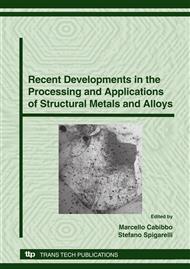p.87
p.97
p.113
p.121
p.133
p.139
p.147
p.155
p.163
FeCrAl Alloys Produced by Roll-Bonding and Annealing of Al(RE)-Clad Stainless Steel: How Addition of Hf and Zr Affects their Oxidation Behaviour
Abstract:
The process involving cold rolling and annealing of Al-steel-Al sandwiches allows to produce an alloy containing more than 7 wt.% of Al. Unfortunately many α-Al2O3 scales tend to spall during thermal cycling because of thermal expansion mismatch between the alloy and the scale. Small additions to the ferritic stainless steel of oxygen reactive elements are known to improve the adhesion of α-Al2O3 scales. In this work hafnium and zirconium were added to the aluminium foil before roll bonding and their behaviour during the diffusion bonding was evaluated. This novel doping method was proven to be effective in improving scale adhesion and alloy lifetime. Moreover it allows to overcome problems related to steel alloying with reactive elements and reduces the quantity of expensive reactive elements that needs to be added to the steel foil.
Info:
Periodical:
Pages:
133-137
Citation:
Online since:
October 2008
Authors:
Price:
Сopyright:
© 2009 Trans Tech Publications Ltd. All Rights Reserved
Share:
Citation:


